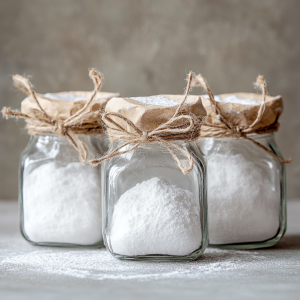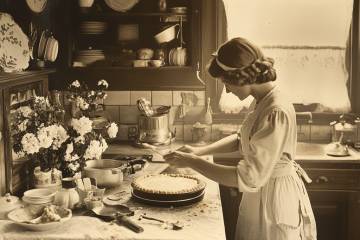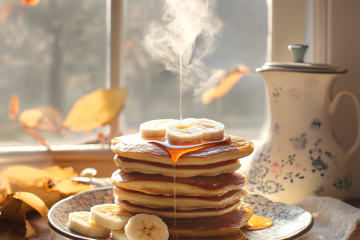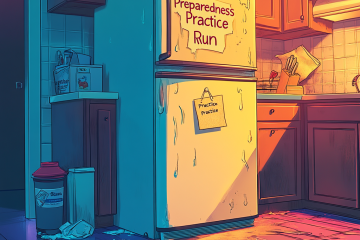
DIY Baking Powder Recipe
The Real Benefits of Homemade Baking Powder: Health and Savings
Baking powder is a staple in many kitchens, quietly working its magic to make our baked goods rise. But have you ever considered making your own? It’s not just a culinary adventure – it’s a smart move for your health and your wallet. Let’s dive into why homemade baking powder deserves a spot in your pantry.
First and foremost, let’s talk about what’s really in that store-bought can. Many commercial baking powders contain aluminum compounds, such as sodium aluminum sulfate or sodium aluminum phosphate. While the FDA considers these safe, some people prefer to avoid aluminum in their diet. When you make your own baking powder, you have complete control over the ingredients. No aluminum, no mysteries – just pure leavening power.
Control is the name of the game when it comes to homemade baking powder. You’re not just avoiding aluminum; you’re steering clear of any additives or anti-caking agents that might be lurking in commercial versions. For those with sensitivities or anyone who’s particular about what goes into their body, this level of control is invaluable. Your homemade version will contain only three simple ingredients: baking soda, cream of tartar, and, optionally, cornstarch.
Impressive Shelf Life of DIY Baking Powder
Another significant advantage of making your own baking powder is the impressive shelf life of its components. Let’s break it down:
- Cream of Tartar: This is the superstar of longevity. Cream of tartar has a nearly unlimited shelf life when stored properly in an airtight container in a cool, dry place. It can last for years, even decades, without losing its potency. This means you can buy in bulk without worrying about waste.
- Baking Soda: When stored in an airtight container in a cool, dry place, baking soda can last indefinitely. However, for optimal leavening power in baking, it’s best to use it within 6 months to 1 year after opening. Generally, its optimal shelf-life for baking is about 2 to 3 years if unopened and stored properly. Once opened, if stored in ideal conditions (airtight, dry, and cool), it can still last for up to 6 months to 1 year for baking use. For non-baking purposes, you can continue using it well beyond that time frame. To test its effectiveness for baking, you can perform a simple test:
Baking Soda Freshness Test:

Get the perfect baked good with DIY Baking Powder
Mix ½ teaspoon of baking soda with 2-3 tablespoons of vinegar. If it bubbles vigorously, it’s still potent for baking. If not, it’s better to replace it for cooking purposes.
- Cornstarch: Cornstarch is quite shelf-stable and can last indefinitely if stored properly in a cool, dry, and airtight container. Its expiration date is more about quality assurance than safety, but if you notice any moisture, clumping, or changes in texture or smell, it’s a sign that it may no longer perform as well. You can always do a test on it to see if it still thicken’s items. But keep in mind that cornstarch is only optional for making your own baking powder and not absolutely necessary. Cornstarch in homemade baking powder does play a crucial role in preventing moisture from triggering the leavening reaction prematurely. By absorbing excess moisture, cornstarch acts as a stabilizer, ensuring that the acid and base components, such as baking soda and cream of tartar, remain dry and inactive until they are mixed into a recipe. This not only helps maintain the effectiveness of the baking powder but also ensures that the ingredients are evenly distributed, providing consistent leavening results in baked goods. Additionally, cornstarch helps extend the shelf life of homemade baking powder, keeping it from clumping or losing its potency over time. Without cornstarch, the mixture would be more susceptible to reacting prematurely or becoming ineffective during storage.
In contrast, store-bought baking powder typically has a shelf life of about 6 months to 1 year once opened, and 18 months if unopened. This is because the ingredients are pre-mixed, which can lead to chemical reactions over time that reduce its effectiveness.
By making your own baking powder in smaller batches, you ensure maximum freshness and effectiveness each time you bake. Plus, with the long shelf life of the individual components, especially cream of tartar, you’re less likely to waste ingredients or money on expired products.
This longevity factor adds another layer to the cost-effectiveness of homemade baking powder. You can buy ingredients in larger quantities at better prices, knowing they’ll stay fresh and effective for a long time. It’s a win-win situation for your wallet and your baking results!
Recipe for DIY Baking Powder
Making your own baking powder is surprisingly simple. Just mix one part baking soda with two parts cream of tartar. If you want to improve its shelf life, add one part cornstarch to the mix. For a practical batch, try 1/4 cup baking soda, 1/2 cup cream of tartar, and 1/4 cup cornstarch. Sift these together, and you’re done!
Save Money by DIY Baking Powder
Now, let’s talk dollars and cents, because making your own baking powder isn’t just better for you – it’s substantially easier on your wallet too. Let’s break it down with a cost comparison using current prices:
Store-bought aluminum-free baking powder:
- Cost per ounce: $0.93
Homemade baking powder:
- Cream of tartar: $19.99 for 2.75 pounds (44 oz)
- Baking soda: $0.89 for 16 oz box
- Cornstarch: $0.13 per oz (via Sam’s Club)
To make 8 oz of baking powder, you’ll need:
- 4 oz cream of tartar: $1.82 ($19.99 / 44 oz * 4 oz)
- 2 oz baking soda: $0.11 ($0.89 / 16 oz * 2 oz)
- 2 oz cornstarch: $0.26 ($0.13 * 2 oz)
Total cost for 8 oz homemade: $2.19 Cost per ounce: $0.27
Comparing the costs:
- Store-bought aluminum-free: $0.93 per oz
- Homemade: $0.27 per oz
That’s a savings of about 71% when you make your own baking powder!
Let’s put this into perspective. If you typically go through one 8 oz can of store-bought aluminum-free baking powder every couple of months, you’re spending about $44.64 per year. By switching to homemade, you could bring that cost down to just $12.96 per year, saving an impressive $31.68 annually. You could get a few mylar bags for that savings, not to mention the peace of mind in knowing what’s in your baking powder.
But the savings don’t stop there. The ingredients you buy to make baking powder have other uses in your kitchen:
- Cream of tartar is useful for stabilizing egg whites, preventing sugar crystallization in syrups, and even as a cleaning agent.
- Baking soda has numerous uses beyond baking, including cleaning, deodorizing, and even personal care.
- Cornstarch is a versatile thickener for sauces, soups, and pie fillings. I also coat my homemade French fries with it to make them crispy on the outside.

Make your own baking powder
So not only are you saving money on baking powder, but you’re stocking your pantry with versatile ingredients that can be used in many ways.
Store your creation in an airtight container, label it with the date, and use it within about six months for best results. When baking, use it just as you would store-bought baking powder – generally, one teaspoon per cup of flour in your recipe.
By making your own baking powder, you’re not just creating a key ingredient; you’re taking a step towards a healthier, more controlled baking experience. You know exactly what’s going into your food, you’re avoiding unnecessary additives, and you’re likely saving money in the long run, especially if you bake frequently.
So, the next time you’re preparing to whip up a batch of muffins or a beautiful cake, reach for your homemade baking powder. It’s more than just an ingredient; it’s a choice for better health and smarter spending. Happy baking, and may your creations always be pure, powerful, and perfectly risen!


